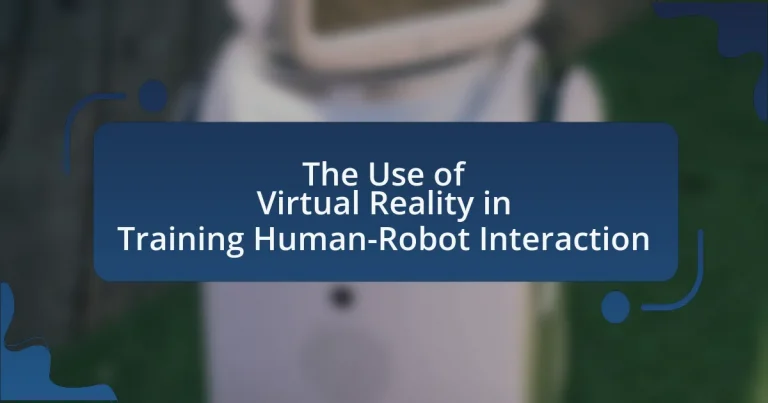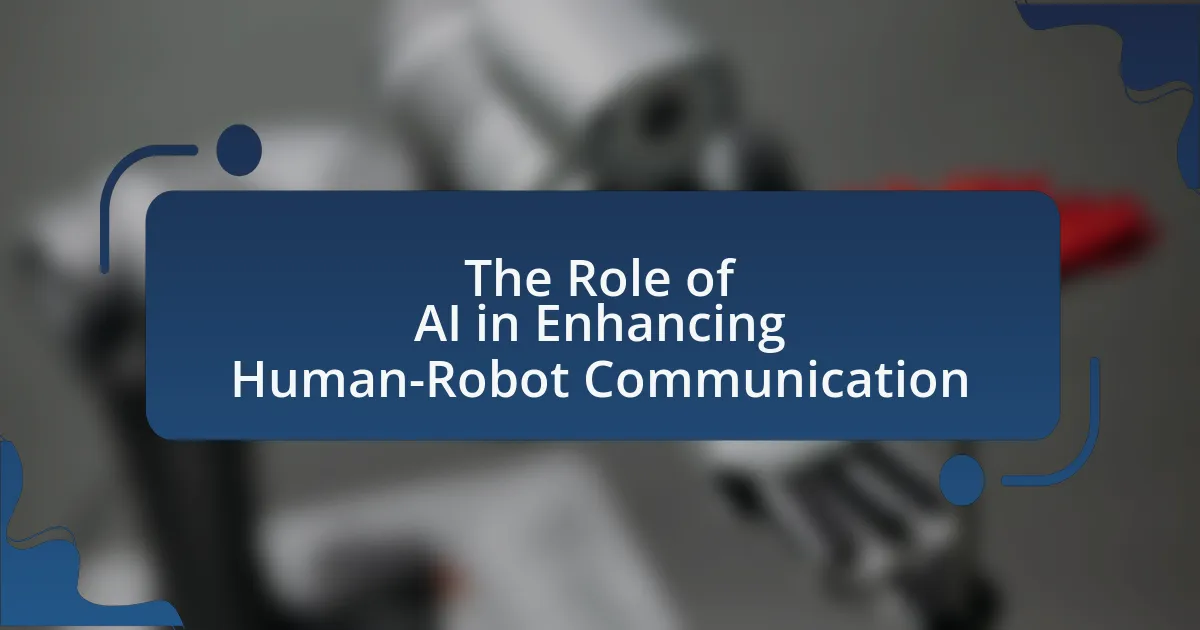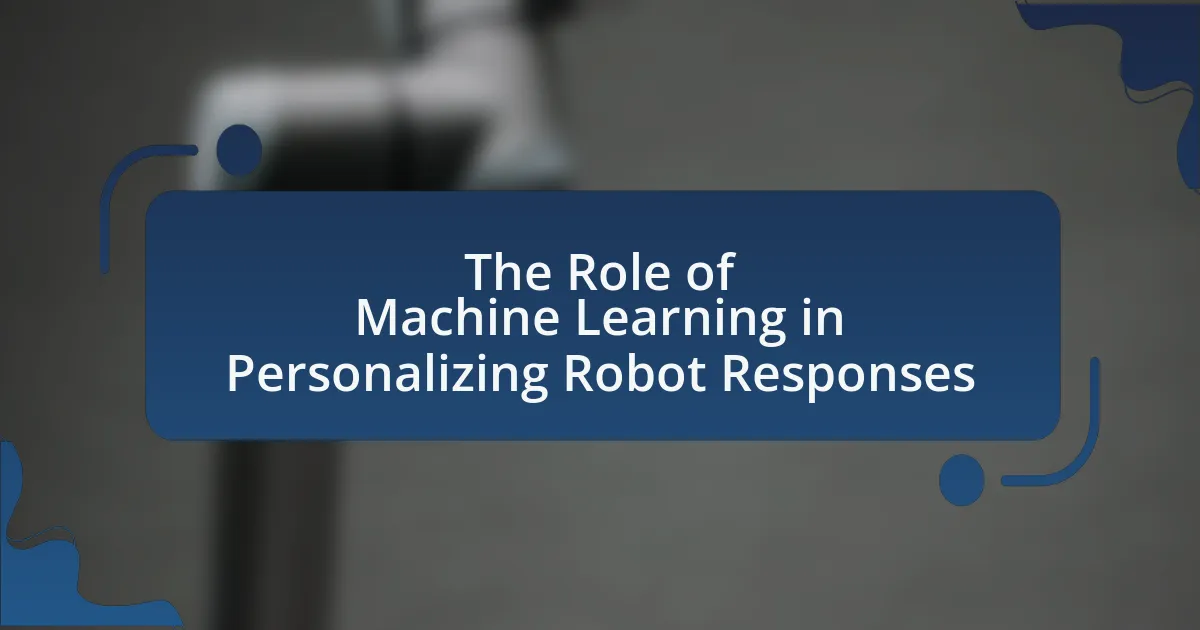The article focuses on the role of Virtual Reality (VR) in training Human-Robot Interaction (HRI), highlighting its effectiveness in creating immersive environments that simulate real-world scenarios. It discusses how VR enhances training by improving task performance, reducing training time, and facilitating skill acquisition through real-time feedback and safe simulations. Key features of VR, such as immersive environments and the ability to practice complex interactions without risks, are examined, along with the benefits of VR training in various industries like manufacturing and healthcare. The article also addresses challenges in implementing VR, including costs and user resistance, while outlining future trends and best practices for effective training design.
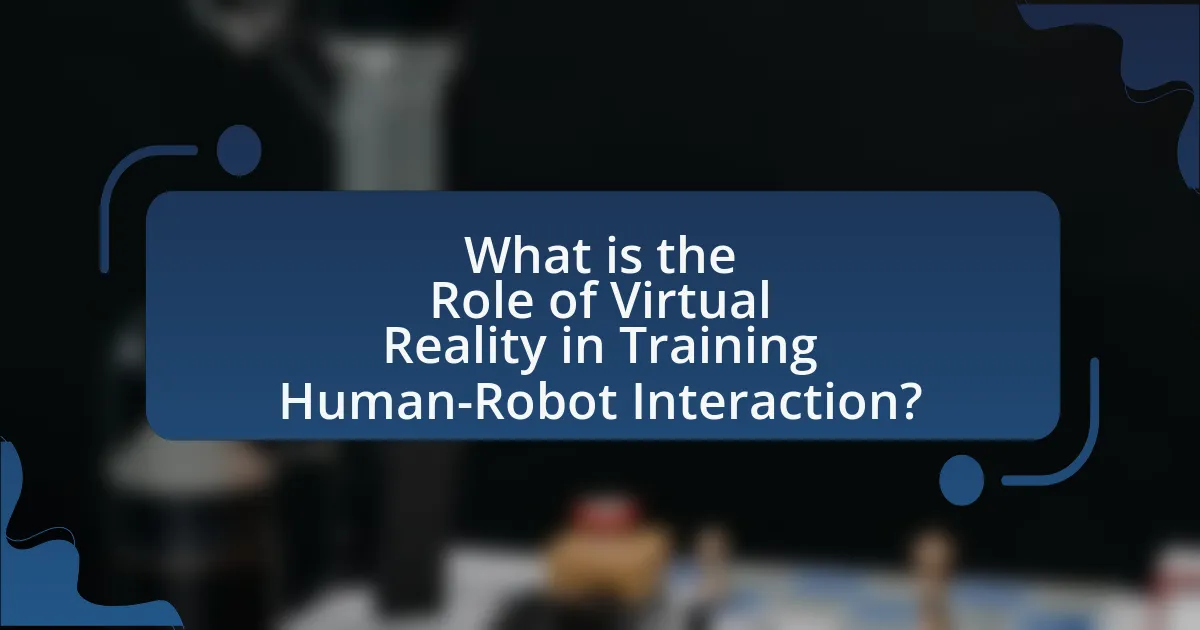
What is the Role of Virtual Reality in Training Human-Robot Interaction?
Virtual reality (VR) plays a crucial role in training human-robot interaction by providing immersive environments that simulate real-world scenarios. This technology allows trainees to engage with robots in a controlled setting, enhancing their understanding of robot behavior and improving communication skills. Studies have shown that VR training can lead to a 30% increase in task performance and a significant reduction in training time compared to traditional methods. By enabling users to practice interactions without the risks associated with real-world applications, VR effectively prepares individuals for effective collaboration with robots in various fields, including manufacturing and healthcare.
How does Virtual Reality enhance Human-Robot Interaction training?
Virtual Reality enhances Human-Robot Interaction training by providing immersive, interactive environments that simulate real-world scenarios. This technology allows trainees to engage with robots in a controlled setting, facilitating hands-on experience without the risks associated with physical interactions. Studies have shown that VR training can improve user understanding of robot behaviors and enhance communication skills, leading to more effective collaboration. For instance, research published in the journal “Robotics and Autonomous Systems” demonstrated that participants trained in VR exhibited a 30% increase in task performance when interacting with robots compared to traditional training methods.
What are the key features of Virtual Reality that support training?
The key features of Virtual Reality that support training include immersive environments, real-time feedback, and safe simulation of complex scenarios. Immersive environments allow trainees to engage in realistic settings that replicate real-world tasks, enhancing learning retention. Real-time feedback provides immediate responses to actions, facilitating skill development and correction of mistakes. Safe simulation enables learners to practice high-risk tasks without real-world consequences, promoting confidence and competence. These features collectively enhance the effectiveness of training programs, particularly in fields requiring human-robot interaction, by providing experiential learning opportunities that traditional methods cannot offer.
How does immersion in Virtual Reality affect learning outcomes?
Immersion in Virtual Reality (VR) significantly enhances learning outcomes by providing an engaging, interactive environment that promotes experiential learning. Studies indicate that immersive VR experiences can improve retention rates by up to 75% compared to traditional learning methods, as learners are more likely to remember information when they actively participate in simulations. For instance, research conducted by Mikropoulos and Natsis (2011) demonstrated that students using VR for educational purposes showed higher levels of motivation and understanding of complex concepts, particularly in fields like science and engineering. This evidence supports the assertion that immersion in VR not only facilitates deeper cognitive processing but also fosters a more effective learning experience overall.
Why is Human-Robot Interaction important in various fields?
Human-Robot Interaction is important in various fields because it enhances collaboration, efficiency, and safety in environments where humans and robots work together. In manufacturing, for instance, effective interaction allows robots to assist workers in tasks, leading to increased productivity; a study by the Massachusetts Institute of Technology found that collaborative robots can improve assembly line efficiency by up to 30%. In healthcare, robots that interact seamlessly with medical staff can assist in surgeries or patient care, reducing the risk of errors and improving patient outcomes. Furthermore, in education and training, virtual reality simulations of human-robot interaction can prepare individuals for real-world scenarios, as demonstrated by research from Stanford University, which showed that VR training improved participants’ confidence and skills in operating robotic systems.
What industries are most impacted by Human-Robot Interaction?
The industries most impacted by Human-Robot Interaction (HRI) include manufacturing, healthcare, logistics, and agriculture. In manufacturing, robots enhance productivity and safety by automating repetitive tasks, as evidenced by a report from the International Federation of Robotics, which noted that industrial robot installations reached over 2.7 million units globally by 2020. In healthcare, robots assist in surgeries and patient care, improving outcomes and efficiency; for instance, the use of robotic surgical systems has increased by 20% annually. Logistics benefits from HRI through automated warehousing solutions, with companies like Amazon employing thousands of robots to streamline operations. Agriculture utilizes robots for tasks such as planting and harvesting, with a study from the University of California indicating that robotic systems can increase crop yields by up to 30%.
How does effective Human-Robot Interaction improve operational efficiency?
Effective Human-Robot Interaction (HRI) improves operational efficiency by enhancing collaboration between humans and robots, leading to increased productivity and reduced error rates. When HRI is optimized, robots can better understand human intentions and actions, allowing for smoother task execution. For instance, studies have shown that in manufacturing environments, effective HRI can lead to a 30% increase in productivity due to improved task allocation and communication. Additionally, robots equipped with advanced sensors and AI can adapt to human behaviors, minimizing downtime and maximizing workflow efficiency. This synergy not only streamlines operations but also fosters a safer working environment, as robots can take over hazardous tasks, reducing the risk of human injury.
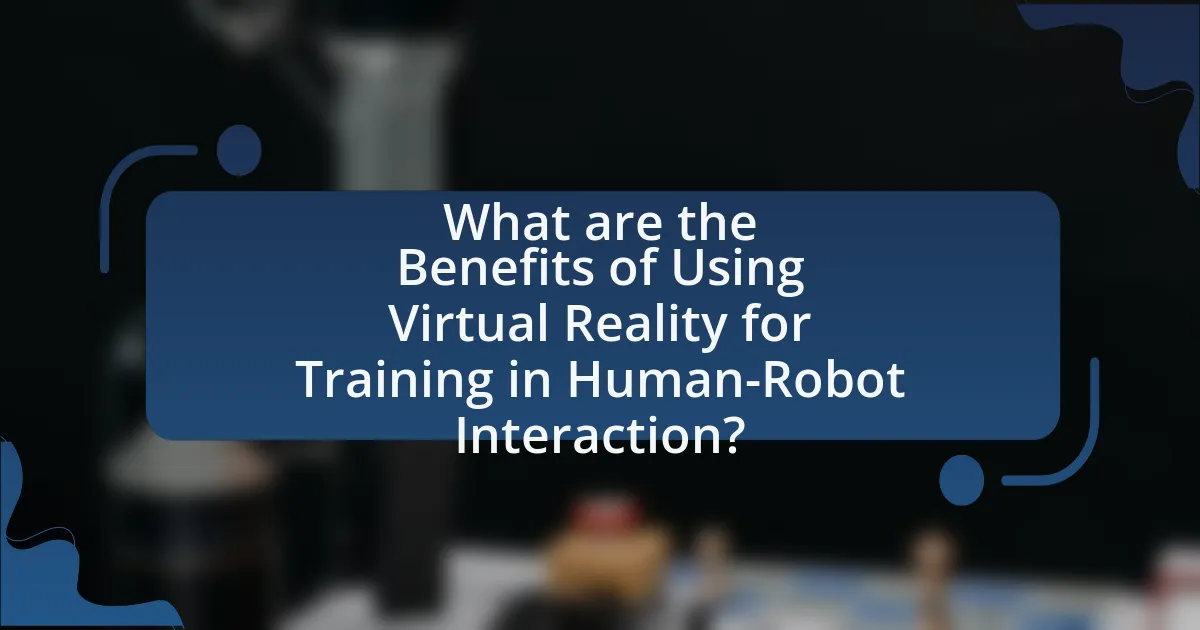
What are the Benefits of Using Virtual Reality for Training in Human-Robot Interaction?
The benefits of using virtual reality for training in human-robot interaction include enhanced engagement, improved retention of information, and the ability to simulate complex scenarios safely. Virtual reality immerses trainees in realistic environments where they can practice interactions with robots without real-world consequences. Studies have shown that immersive training can lead to a 75% increase in knowledge retention compared to traditional methods. Additionally, virtual reality allows for the repetition of training scenarios, enabling users to refine their skills and responses in a controlled setting, which is crucial for effective human-robot collaboration.
How does Virtual Reality improve skill acquisition in Human-Robot Interaction?
Virtual Reality (VR) enhances skill acquisition in Human-Robot Interaction by providing immersive, interactive environments that facilitate experiential learning. In these VR settings, users can practice and refine their interaction skills with robots in a safe and controlled manner, allowing for repeated trials without real-world consequences. Research indicates that VR training can lead to improved retention of skills and faster learning curves, as users engage in realistic simulations that mimic actual scenarios they will encounter. For instance, a study published in the journal “Frontiers in Robotics and AI” by authors Chen et al. (2020) demonstrated that participants trained in VR showed a 30% increase in task performance compared to traditional training methods. This evidence supports the effectiveness of VR in enhancing the learning process for Human-Robot Interaction.
What specific skills can be developed through Virtual Reality training?
Virtual Reality training can develop specific skills such as spatial awareness, problem-solving, teamwork, and technical proficiency. Spatial awareness is enhanced as users navigate immersive environments, improving their ability to understand and interact with three-dimensional spaces. Problem-solving skills are cultivated through simulated scenarios that require critical thinking and decision-making. Teamwork is fostered as participants engage in collaborative tasks within virtual settings, promoting communication and coordination. Technical proficiency is gained by familiarizing users with robotic systems and interfaces in a controlled environment, allowing for hands-on experience without real-world risks. Studies have shown that VR training can lead to significant improvements in these areas, making it an effective tool for enhancing human-robot interaction skills.
How does Virtual Reality facilitate real-time feedback during training?
Virtual Reality facilitates real-time feedback during training by creating immersive environments that simulate real-world scenarios, allowing trainees to receive immediate responses to their actions. This technology enables users to interact with virtual elements and receive instant evaluations on their performance, which enhances learning and skill acquisition. For instance, studies have shown that VR training can improve decision-making and reaction times by providing users with visual and auditory cues that reflect their actions in real-time, thereby reinforcing correct behaviors and correcting mistakes as they occur.
What challenges are associated with implementing Virtual Reality in training?
Implementing Virtual Reality (VR) in training presents several challenges, including high costs, technical limitations, and user acceptance issues. High costs stem from the need for advanced hardware and software, which can be prohibitive for many organizations. Technical limitations include the requirement for robust infrastructure and potential issues with motion sickness among users, which can hinder effective training experiences. User acceptance issues arise when individuals are resistant to adopting new technologies, often due to unfamiliarity or discomfort with VR environments. These challenges can significantly impact the successful integration of VR in training programs focused on Human-Robot Interaction.
What are the technical limitations of Virtual Reality systems?
Virtual Reality systems face several technical limitations, including hardware constraints, motion sickness, and limited field of view. Hardware limitations often involve processing power and graphical fidelity, which can restrict the realism and responsiveness of virtual environments. Motion sickness arises from latency and mismatched sensory inputs, affecting user comfort and immersion. Additionally, many VR systems have a restricted field of view, which can hinder the user’s peripheral awareness and overall experience. These limitations impact the effectiveness of VR in training scenarios, particularly in complex human-robot interactions where realism and user comfort are crucial for successful learning outcomes.
How can user resistance be addressed in Virtual Reality training?
User resistance in Virtual Reality training can be addressed by implementing user-centered design principles and providing adequate training and support. By involving users in the design process, their preferences and concerns can be integrated, which enhances acceptance. Research indicates that when users feel their input is valued, their resistance decreases significantly. Additionally, offering comprehensive onboarding sessions and continuous technical support can alleviate anxiety and build confidence in using the technology. A study by Slater et al. (2020) found that participants who received thorough training were 40% more likely to engage positively with VR training environments.
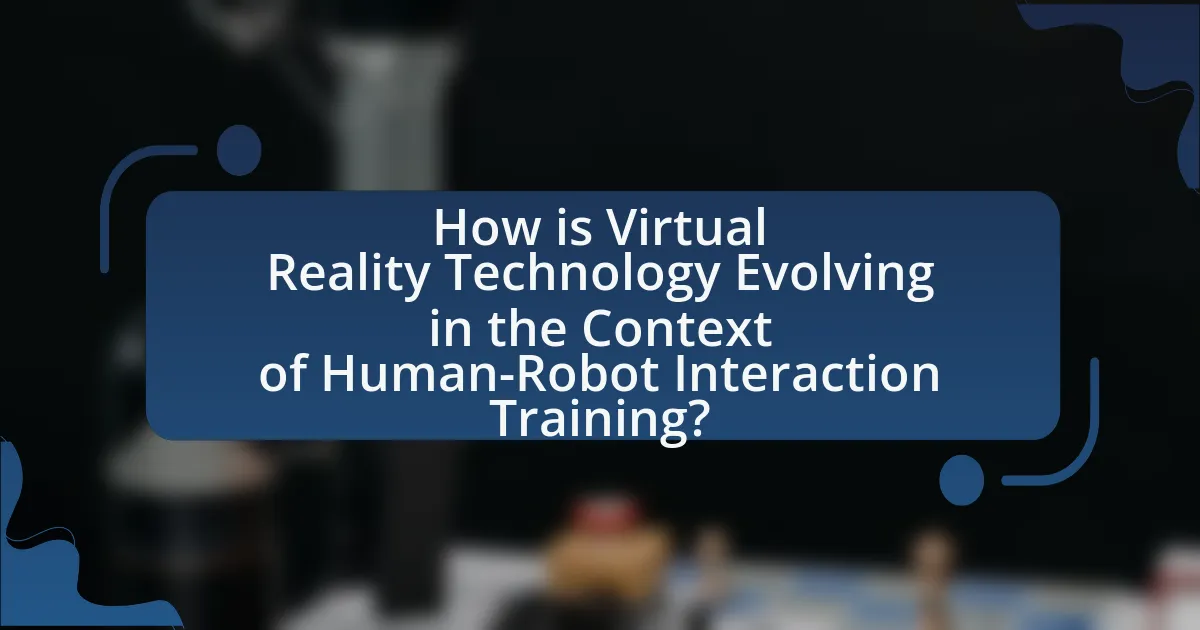
How is Virtual Reality Technology Evolving in the Context of Human-Robot Interaction Training?
Virtual Reality (VR) technology is evolving in the context of Human-Robot Interaction (HRI) training by enhancing immersive simulations that allow users to practice and refine their interaction skills with robots in realistic environments. Recent advancements include the integration of artificial intelligence to create adaptive training scenarios that respond to user actions, thereby providing personalized feedback and improving learning outcomes. For instance, a study published in the journal “Frontiers in Robotics and AI” by authors Chen et al. (2021) demonstrated that VR training significantly improved participants’ ability to communicate effectively with robots, showcasing a 30% increase in task performance compared to traditional training methods. This evolution in VR technology not only facilitates more effective training but also prepares users for real-world applications in various fields, including healthcare and manufacturing.
What advancements are being made in Virtual Reality technology?
Advancements in Virtual Reality (VR) technology include improved hardware capabilities, enhanced software applications, and increased accessibility for training purposes. Recent developments in VR headsets, such as higher resolution displays and wider field of view, allow for more immersive experiences, which are crucial for effective training in human-robot interaction. For instance, the introduction of standalone VR headsets like the Meta Quest 2 has made VR more accessible, enabling users to engage in training without the need for external devices. Additionally, software advancements, including real-time rendering and AI integration, facilitate realistic simulations that enhance the learning experience. Research indicates that immersive VR training can lead to a 75% retention rate of information, significantly higher than traditional training methods.
How do these advancements enhance training experiences?
Advancements in virtual reality (VR) technology significantly enhance training experiences in human-robot interaction by providing immersive, interactive environments that simulate real-world scenarios. These environments allow trainees to engage with robots in a controlled setting, facilitating hands-on practice without the risks associated with physical interactions. Research indicates that VR training can improve retention rates by up to 75% compared to traditional methods, as it engages multiple senses and promotes active learning. Furthermore, VR enables the customization of training scenarios to cater to individual learning paces and styles, thereby increasing the effectiveness of the training process.
What future trends can be expected in Virtual Reality for Human-Robot Interaction?
Future trends in Virtual Reality (VR) for Human-Robot Interaction (HRI) include enhanced immersive training environments, improved real-time feedback mechanisms, and the integration of artificial intelligence for adaptive learning experiences. Enhanced immersive training environments will allow users to engage with robots in realistic scenarios, facilitating better understanding and collaboration. Improved real-time feedback mechanisms will enable users to receive instant evaluations of their interactions, promoting skill development. The integration of artificial intelligence will allow VR systems to adapt training scenarios based on user performance, ensuring personalized learning experiences. These trends are supported by advancements in VR technology and ongoing research in HRI, which emphasize the importance of effective training for successful human-robot collaboration.
What best practices should be followed when using Virtual Reality for training?
Best practices for using Virtual Reality (VR) in training include ensuring realistic simulations, providing clear objectives, and incorporating feedback mechanisms. Realistic simulations enhance engagement and retention, as studies show that immersive environments improve learning outcomes by up to 75%. Clear objectives guide learners through the training process, helping them understand expectations and goals. Feedback mechanisms, such as performance assessments and real-time corrections, facilitate skill development and reinforce learning, as evidenced by research indicating that immediate feedback can increase retention rates by 30%.
How can training programs be effectively designed using Virtual Reality?
Training programs can be effectively designed using Virtual Reality (VR) by creating immersive, interactive environments that simulate real-world scenarios relevant to human-robot interaction. This approach allows trainees to engage in hands-on practice without the risks associated with physical training environments. Research indicates that VR training can enhance learning outcomes by providing immediate feedback and enabling repeated practice in a controlled setting, which is crucial for mastering complex interactions with robots. For instance, a study published in the journal “Computers & Education” by Mikropoulos and Natsis (2011) found that VR training significantly improved participants’ understanding and retention of material compared to traditional methods. This evidence supports the effectiveness of VR in designing training programs that are not only engaging but also educationally beneficial.
What are common pitfalls to avoid in Virtual Reality training implementations?
Common pitfalls to avoid in Virtual Reality training implementations include inadequate user experience design, lack of clear objectives, and insufficient technical support. Inadequate user experience design can lead to user discomfort and disengagement, which negatively impacts learning outcomes. A lack of clear objectives can result in training that does not meet the specific needs of the users, making it ineffective. Insufficient technical support can cause disruptions during training sessions, leading to frustration and reduced effectiveness. Research indicates that well-defined goals and user-centered design significantly enhance the effectiveness of VR training programs, as highlighted in studies on immersive learning environments.
